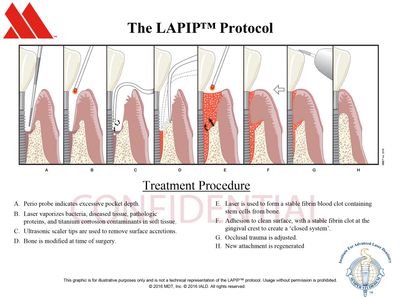LAPIP
LAPIP
Dental implants are considered by many dentists to be one of the most effective tooth-replacement treatments available. Carrying a 97 percent success rate (or higher), they give patients suffering from tooth loss a second chance at a beautiful smile, and when properly cared for, they can last a lifetime. Like any medical procedure, however, dental implants can fail. The number one complication causing dental implant failure is peri-Implantitis, a form of gum disease affecting implants. Peri-implantitis affects about a third of all dental implant patients.
Dr. Vikas Bhasin
is committed to helping you protect your dental implant investment. To do so, he employs the most advanced dental tools available, such as the LAPIP protocol which can help to destroy bacteria causing inflammation before it harms your implants. Learn more about protecting your dental implants by calling (02) 4655-3705
or emailing reception@camdendental.com.au
for an appointment.
What Is Peri-Implantitis?
Peri-implantitis is an infection of the periodontal tissue (gums) around your dental implants. In the beginning stages, gums may appear red or “puffy-looking.” This is sometimes called “mucositis,” similar to gingivitis. As the condition advances, surrounding gum tissue will recede, bone loss will occur, and eventually your dental implants can fail.
Dental implants work by forming a strong connection with the jaw bone. After dental implants have been surgically inserted, bone and tissue will fuse to the titanium implant in a process known as osseointegration. Peri-implantitis is a bacterial infection of the bone which attaches to the dental implant. When this bone is damaged, the connection holding the implant becomes weaker, which leads to dental implant failure.

What Causes Peri-implantitis?
Much like gum disease, peri-implantitis is the result of many different factors: oral hygiene, genetics, poor immune system, or habits like smoking. At its root, the condition is a bacterial infection of the gum tissue which causes the tissue to become inflamed. There are around 8 billion bacteria living in your mouth at any given point. For the most part, they live in harmony with one another, but given the right circumstances -- food sources, dry mouth, etc. -- they can begin to overpopulate and cause damage to gum tissue, teeth, and dental implants.
How to Treat Peri-implantitis and Protect Your Dental Implants
In the past, traditional treatment for peri-implantitis included invasive oral surgery. Bacteria which causes peri-implantitis will generally burrow deep within the gums and bone. In order to effectively clean these areas, dentists would have to make an incision, suture the periodontal pockets, and possibly graft gum tissue back together. Sometimes more advanced procedures use bone graft and membranes to attempt bone regeneration. The LAPIP protocol is an advanced treatment using the dental laser, PerioLase MVP-7.
Compared with traditional treatment methods, the LAPIP protocol has a wealth of patient benefits, including:
- Faster recovery
- Less pain
- No gum recession
- Encourages healthy tissue regeneration
Nearly the thickness of three human hairs, the PerioLase MVP-7 can slip in between gum and dental implant to eliminate bacteria infection without the need of a scalpel. Because the laser works at a specific wavelength the minimizes the damage done to healthy tissue, it can also promote faster healing.
If you’re suffering from peri-implantitis, the LAPIP protocol is a no-risk treatment that will help you to preserve your dental implant investment, as well as the health of your gums. It can even be done in one treatment! For more information about preserving your dental implants, please call (02) 4655-3705
or email reception@camdendental.com.au
to schedule an appointment.
Office Hours
Monday: 8 am - 5:30 pm
Tuesday: 8:30 am - 7 pm
Wednesday: 8:30 am - 7 pm
Thursday: 8:30 am - 5:30 pm
Friday: 8:30 am - 5 pm
Saturday: 8 am - 12 pm
Sunday: Closed
COPYRIGHT © 2020 SYDNEY LASER GUM CENTRE | SITEMAP | WEBSITE BY
PRO IMPRESSIONS MARKETING GROUP


